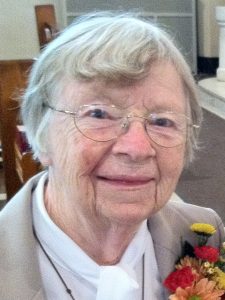 We thank Sister Paula Bingert, our parish/school historian, whose knowledge of the parish and school history makes possible this wonderful story.
We thank Sister Paula Bingert, our parish/school historian, whose knowledge of the parish and school history makes possible this wonderful story.
Sister Paula is a Franciscan Sister who served as the elementary school librarian at St. Peter’s School for many years. She retired and now resides at Our Lady of Angels in Joliet, Illinois.
INTRODUCTION
It helps now and then to step back and take the long view. The kingdom is not only beyond our efforts; it is even beyond our vision.
We accomplish in our lifetime only a tiny fraction of the magnificent enterprise that is God’s work. Nothing we do is complete, which is another way of saying that the kingdom always lies beyond us. No statement says all that could be said. No prayer fully expresses our faith. No confession brings perfection. No pastoral visit brings wholeness. No program accomplishes the church’s mission. No set of goals and objectives includes everything.
This is what we are about. We plant the seeds that one day will grow. We water seeds already planted, knowing that they hold future promise. We lay foundations that will need further development. We provide yeast that produces effects far beyond our capabilities. With the completion of decorating of the church and the return of the men and women from military service in 1946, the parish was ready to celebrate the centennial. Taking part in the celebration was Bishop Michael Ready, a former student of St. Peter’s Elementary School.
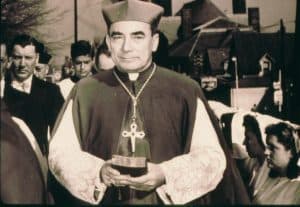
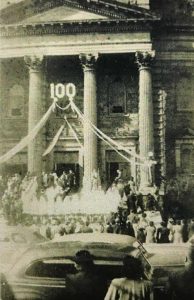 Music always played an important role in the St. Peter’s curriculum. The Sisters offered private music lessons. Gregorian chant was taught. It was used by all the high school students on the mornings that requiem masses were offered. The all-male choir with its boy sopranos enhanced our liturgical celebrations on feast days. The Sister who taught music organized an orchestra and sponsored recitals held each spring to give the music students a chance to perform.
Music always played an important role in the St. Peter’s curriculum. The Sisters offered private music lessons. Gregorian chant was taught. It was used by all the high school students on the mornings that requiem masses were offered. The all-male choir with its boy sopranos enhanced our liturgical celebrations on feast days. The Sister who taught music organized an orchestra and sponsored recitals held each spring to give the music students a chance to perform.
With very few exceptions, the Sisters were the administration and faculty during the early years of the high school. Some thirty Sisters took pride in innovative teaching techniques, visits from diocesan supervisors and continuing education for themselves. Their summers were filled with school and workshops. Sister Edwina Simko was the first high school principal and Sister Tarcisius Welker, 1956-1958, was the last principal who administered both the grade and high schools.
In 1946, the King property to the west of the old high school was purchased. The seventh pastor of our parish, Monsignor R.C. Goebel, initiated a building fund appeal campaign in 1953. He did not live to see his plans completed.
It was Monsignor James Hebbeler who broke ground for the new high school on May 6, 1956. By February of 1957, the steel skeleton was visible.
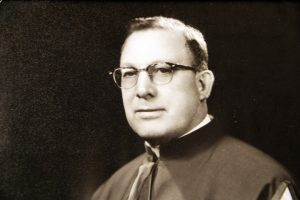
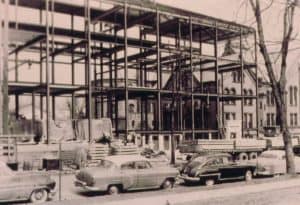 A parishioner, Gus Hartung, stopped every day on his way home from work and snapped pictures. In one of the photos below, the girl and boy standing on the steps of the high school while under construction are his children, Fred and Marilyn (Hartung) Gallaway.
A parishioner, Gus Hartung, stopped every day on his way home from work and snapped pictures. In one of the photos below, the girl and boy standing on the steps of the high school while under construction are his children, Fred and Marilyn (Hartung) Gallaway.
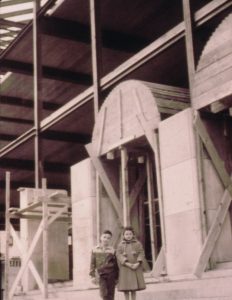 In September of 1958, the new high school opened its doors to 349 students. The school newspaper, The Key, announced the “Dream Come True”. With the land purchase of $30,000 and construction costs at 2.25 million, the top two floors of this new school became the new home of the Franciscan sisters. The remaining floors contained science labs, 14 classrooms, a library, cafeteria and a combination gym-auditorium. As a result, the House of Seven Gables as well as the old high school building were leveled, making way for parking lot facilities for the growing church and school.
In September of 1958, the new high school opened its doors to 349 students. The school newspaper, The Key, announced the “Dream Come True”. With the land purchase of $30,000 and construction costs at 2.25 million, the top two floors of this new school became the new home of the Franciscan sisters. The remaining floors contained science labs, 14 classrooms, a library, cafeteria and a combination gym-auditorium. As a result, the House of Seven Gables as well as the old high school building were leveled, making way for parking lot facilities for the growing church and school.
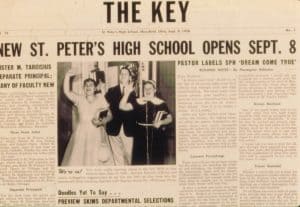 In the first two photos below, you can see the present elementary school and church. The other building in this picture is the red brick school/church building which was later torn down after the high school building was complete.
In the first two photos below, you can see the present elementary school and church. The other building in this picture is the red brick school/church building which was later torn down after the high school building was complete.
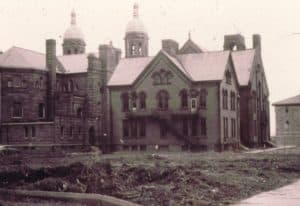
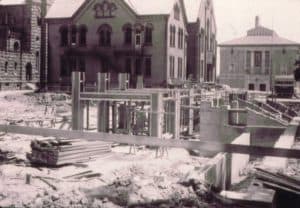
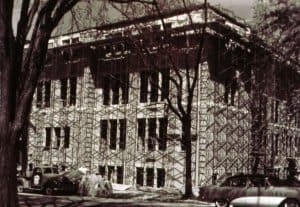
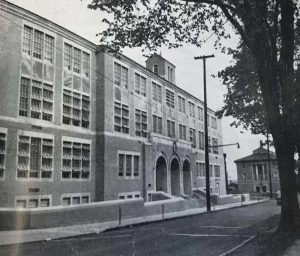
After the new high school opened, the old convent (which stood where the elementary parking lot/playground now stands) and the old high school (red brick building which stood where the church parking lot now stands) were torn down.
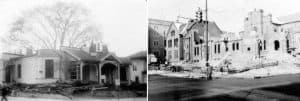
In October of that first year, the local post of the American Legion presented a large American flag and smaller flags for each classroom of the new high school. Also, there was a record number of women – 544 to be exact – present for the meeting of the Mothers’ Club with Mrs. Colangelo presiding. Bishop George Rehring blessed the new building on November 9, 1958.
As the parish and school continued to flourish, there were many new opportunities for involvement. Choirmaster Raymond E. Baum was organist and choir director of 120 young men and adults.
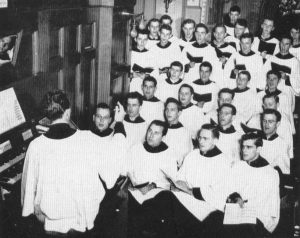
In later years, women were invited to join the choir and now St. Peter’s enjoys music during Sunday liturgies from not only the choir, but the contemporary ensemble, bell choir (started in 1994), and children’s choir.
Students in the elementary school were required to fast before receiving Holy Communion at early day Mass. A group of women parishioners–the St. Rita’s Sodality who were later called the “cocoa ladies”–served hot cocoa to the children in the church basement after Mass. Children would bring their breakfast and top it off with the delicious hot drink.
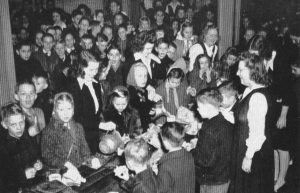
New activities such as bingo and the parish festival became mainstay sources of income for the parish and schools, made possible by many dedicated parishioners through the years.
Parish-sponsored Girl Scout and Boy Scout troops were formed, playing an active role in the lives of elementary and high school children along with a growing and active parish youth group with their many projects and outings.
And there was an increase in adult education, prayer groups, advisory committees, and many other ministries that included scores of parish and school members. Eucharistic ministers, commentators, ushers, and lectors began assisting during Masses. Many church groups used their ministry as a means to connect with and serve the needs of the Mansfield community.
In the late 60’s, enrollments at both schools peaked. To help ease crowded conditions, an abandoned church building at the southeast corner of South Mulberry and First Streets was purchased for a gym and more classrooms. This building came to be called the Annex.
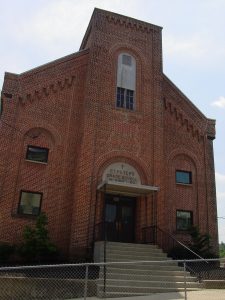
Monsignor Edward Dunn, ninth pastor of St. Peter’s, served the parish from 1969 to 1984. Many parishioners were instrumental in establishing the Monsignor Dunn Foundation for Education in 1985 with an endowment that will assure that St. Peter’s School continues to provide a Catholic education for children for many years to come. During his years, St. Peter’s School also saw the addition of the unique Montessori program in 1976. This program was housed in the Annex. In 1999, St. Peter’s purchased the Montessori House.
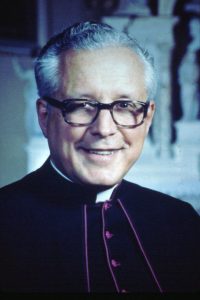
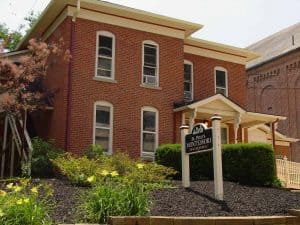
Father John Blaser, tenth pastor of St. Peter’s, called for a parish census and study. These studies produced a wealth of information and insight into the challenges and realities of the times. Future plans and directions were set to meet and respond to changing economic and social situations.
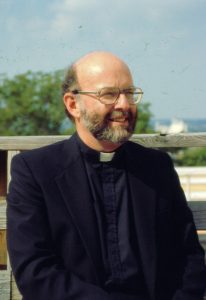
It was Thanksgiving day in 1991 and Father Joseph Szybka was coming down the center aisle after helping with clean up in the cafeteria following dinner for the hungry. His eye caught a boy crossing the sanctuary and the smoke alarm then sounded. Father saw smoke coming from the servers’ sacristy. The fire department responded with great speed and saved the church. Sunday Masses were held in the auditorium. Scaffolding went up in March and in June the parish celebrated a Mass of Thanksgiving inviting choir members from the Inter-Church Council.
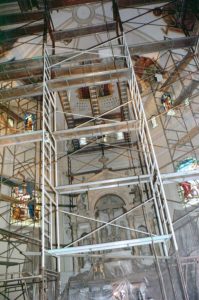
During the late 90’s and early into the 21st century, St. Peter’s eleventh pastor, Father Herbert F. Weber led the challenge of a new capital campaign that met the financial needs for improvements around the grounds of the church and school as well the construction of the Franciscan Activity Center, duly named in honor of the many years hundreds of Franciscan sisters have served here at St. Peter’s.
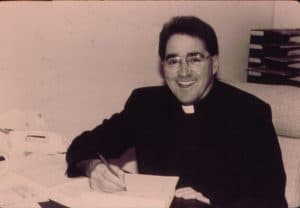
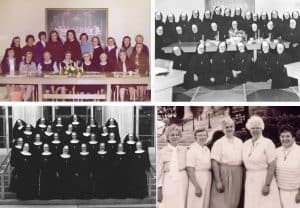
The “tin gym” (white building in background of this photo below) was removed and in its place now stands the Franciscan Activity Center that serves as a gymnasium and reception center for both parish and school functions. The dedication of the Franciscan Activity Center took place on June 13, 1999.
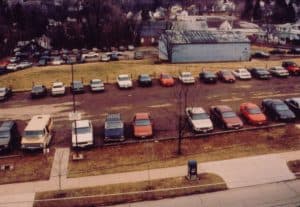
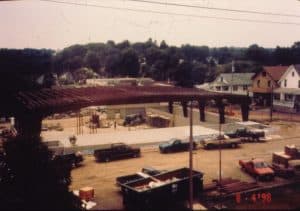
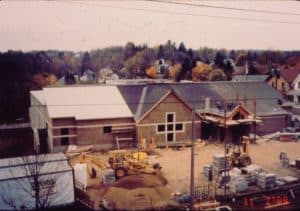
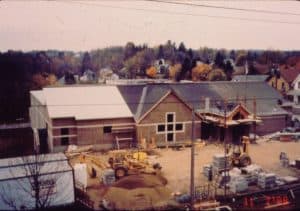

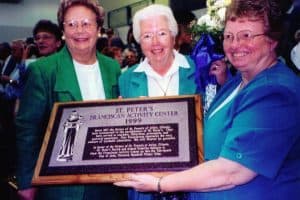
When Father Tony Borgia arrived as the twelfth pastor, one of his first activities was to sign the papers for the Spartan Field located about two miles from school. Presently, it allows the parish school to host soccer, baseball, and softball athletic programs with the prospect of tennis and track in the future. Renovation and building plans continue under the direction of an adept team of parish and school adults so the future holds even more promise for school and parish gatherings.
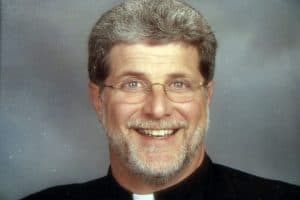
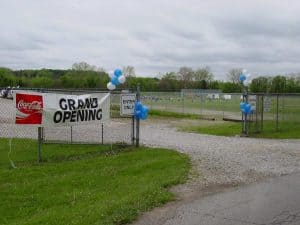
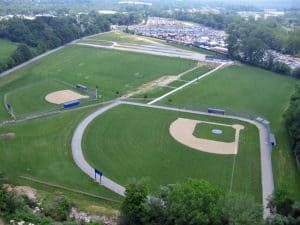
The year 2011 was marked by the arrival in July of the thirteenth pastor of St. Peter’s Parish, Father Gregory Hite. With experience as pastor and educational leader in his previous assignments, Father Hite has met the challenge of finances to generate creative strategies that will secure for the members of St. Peter’s Parish and students of St. Peter’s School a strong faith and academic experience.
Under his leadership, the “Preserving our Past, Securing our Future” Campaign campaign has the goal of $3 million to renew and improve the church (now complete) and school, address the needs of the Robert Frye gymnasium and auditorium, plus security enhancements and other smaller projects.
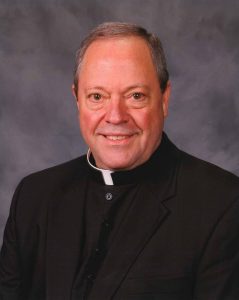
CLOSING
The challenge of St. Peter’s has always been to bring people to a faith which will be a model to children as well as to each other. The call of the laity of the church and school students and parents alike is to be active, involved, and fully participating members of their parish and school. Throughout these many years, individuals who have been a part of St. Peter’s at any time have focused on spiritual and academic hopes and aspirations in different ways, called upon to build up the Kingdom of God by deepening their own interior lives, by rendering generous service to those in spiritual or material need, and by giving authentic witness to the truth of the Gospel. We pause to honor and thank those who made our parish and school great, to each of you who have kept it great. Let us pray that we may keep the faith of those who have gone before us and pass it on to our children and their children.
